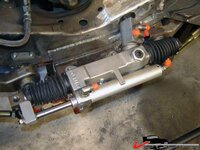Twin_Turbo
Der Maulwurf
- Joined
- Mar 5, 2008
- Messages
- 7,579
Yeah, there's not much to it really. A pump, a drive mandrel, some hoses, a tank and a filter (or multiple, depending on filtered scavenge lines and such)
Nothing the frame is really easy, notching the frame and having to incorporate a hole for a steering shaft, now then it gets exciting
Nothing the frame is really easy, notching the frame and having to incorporate a hole for a steering shaft, now then it gets exciting


